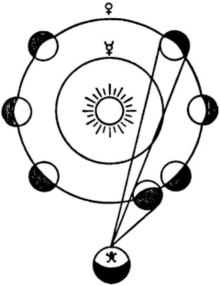The Epitome Astronomiae Copernicanae was an astronomy book on the heliocentric system published by Johannes Kepler in the period 1618 to 1621. The first volume (books I–III) was printed in 1618, the second (book IV) in 1620, and the third (books V–VII) in 1621.



Content
editThe book contained in particular the first version in print of his third law of planetary motion. The work was intended as a textbook, and the first part was written by 1615.[1] Divided into seven books, the Epitome covers much of Kepler's earlier thinking, as well as his later positions on physics, metaphysics and archetypes.[2] In Book IV he supported the Copernican cosmology.[3] Book V provided mathematics underpinning Kepler's views.[2] Kepler wrote and published this work in parallel with his Harmonices Mundi (1619), the last Books V to VII appearing in 1621.[4]
Kepler introduced the idea that the physical laws determining the motion of planets around the Sun were the same governing the motion of moons around planets. He justified this claim in Book IV using the telescope observations of the moons of Jupiter made by Simon Marius in his 1614 book Mundus Iovialis. The period of orbits and relative distances of the four moons satisfied Kepler's third law and he argued the Jovian system was like a mini Solar System.[5]
Reception
editDue to the book's support for heliocentrism, the first volume was put on the Index of Prohibited Books on 28 February 1619.[7]
Editions
edit- 1635 reprint: Epitome Astronomiae Copernicanae, Vols. 1–3, Schönwetterus.
Translations
edit- 1939: Epitome of Copernican astronomy. Books IV and V, The organization of the world and the doctrine ...; trans. by Charles Glenn Wallis. Annapolis: St John's Bookstore.
- 1955: Reissued with Ptolemy's Almagest. Chicago: Encyclopædia Britannica (1955).
- 1995: Epitome of Copernican astronomy; & Harmonies of the world; translated by Charles Glenn Wallis. Amherst: Prometheus Books.
Notes
edit- ^ Max Caspar (10 October 2012). Kepler. Courier Dover Publications. p. 239. ISBN 978-0-486-15175-5.
- ^ a b Rhonda Martens (29 October 2000). Kepler's Philosophy and the New Astronomy. Princeton University Press. p. 142. ISBN 0-691-05069-4.
- ^ Roy Porter; Katharine Park; Lorraine Daston (3 July 2006). The Cambridge History of Science: Volume 3, Early Modern Science. Cambridge University Press. p. 41. ISBN 978-0-521-57244-6.
- ^ J. R. Mulryne (1 January 2004). Europa Triumphans: Court and Civic Festivals in Early Modern Europe. Ashgate Publishing, Ltd. p. 12. ISBN 978-0-7546-3873-5.
- ^ Linton, C. M. (2004). From Eudoxus to Einstein. Cambridge: Cambridge University Press. p. 218. ISBN 978-0-521-82750-8.
Kepler invoked numerous justifications... One of these involved applying his third law to the four newly discovered moons of Jupiter, the data for which he obtained from Simon Mayr's World of Jupiter
- ^ Lawrence Nolan (ed.), The Cambridge Descartes Lexicon, Cambridge University Press, 2016, "Inertia.", p. 405
- ^ Maurice Finocchiario, Retrying Galileo, 1633-1992, Chapter 1, page 20